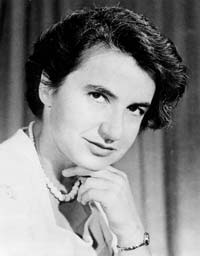
| Born: Jul 25, 1920 in Notting Hill, London |
| Died: Apr 16, 1958 (at age 37) in Chelsea, London |
| Nationality: British |
| Famous For: DNA structure, virus structure, structure of graphite & coal |
Rosalind Franklin, a famous scientist from London, laid the groundwork for many scientists in the area of genetics. Her role in discovering the DNA’s helical structure was widely acknowledged during her lifetime.
Early Years
Rosalind Franklin was the second of the five children in her family. She attended school at St. Paul’s Girls School in London and got graduated with a degree in chemistry from the University of Cambridge. After graduating from Cambridge she remained at the university to study gas-phase chromatography.
She worked as an assistant research officer from 1942 to 1946 at the British Coal Utilisation Association, where she studied about the physical structure of coal. She attained her doctorate degree for this work at Cambridge University. Her thesis work was titled “The Physical Chemistry of Organic Colloids with Special Reference to Coal.”
In 1947, Rosalind Franklin moved to Paris, where she was hired at the Laboratoire Central des Services Chimiques de L’Etat. There she worked with a crystallographer named Jaques Mering who taught her the techniques of X-ray diffraction. This played a major role in her discovery of the DNA structure.
Rosalind used the technique of X-ray diffraction to identify the differences between carbon atoms that get converted into graphite when heat is applied and those that do not. This led to the discovery of a new technology called carbon-fiber technology.
Studying DNA
In 1951, Rosalind joined the Medical Research Unit at King’s College where she was recruited by John Randall to work on the structure of DNA. Though DNA was discovered by Johann Meischer in the year 1898, no scientific methods were developed till the mid 20th century to discover the actual structure of DNA. Franklin’s work was the key to that methodology; to find the structure of DNA.
From 1951 to 1953, Rosalind worked on the DNA molecule using X-ray diffraction. The photographs taken by Rosalind using X-ray crystallography made it known that there were two forms of DNA, a dry “A” form and a wet “B” form. One of the pictures of the “B” version of DNA, taken using X-ray crystallography, became critical evidence in identifying the structure of DNA.
In 1953, Rosalind’s work laid the foundation for scientist’s Francis Crick and James Watson to suggest that the structure of DNA was a double-helix polymer. Rosalind continued her work in the crystallography laboratory from 1953 to 1958 at Birkbeck College, London, where she completed her works on coal and DNA. She started to work on a new project studying the molecular structure of the tobacco mosaic virus. She discovered that the RNA in the virus was embedded in the protein rather than in its central portion. She concluded that RNA had a single-stranded helical structure.
Final Days
In 1958, Rosalind found that she had tumors in her abdominal area. While undergoing treatment for cancer, she continued to do her research work. She died at the very young age of 37 in 1958.